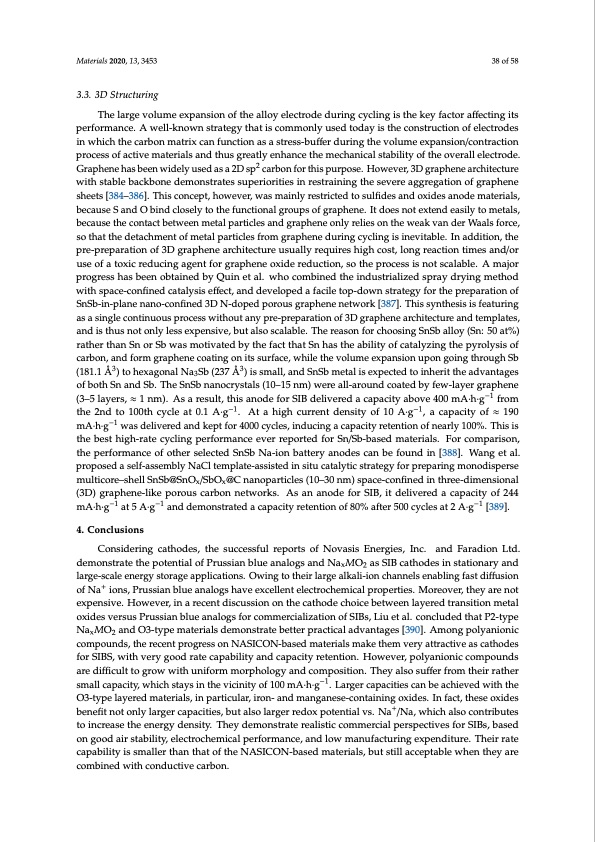
PDF Publication Title:
Text from PDF Page: 038
Materials 2020, 13, 3453 38 of 58 3.3. 3D Structuring The large volume expansion of the alloy electrode during cycling is the key factor affecting its performance. A well-known strategy that is commonly used today is the construction of electrodes in which the carbon matrix can function as a stress-buffer during the volume expansion/contraction process of active materials and thus greatly enhance the mechanical stability of the overall electrode. Graphene has been widely used as a 2D sp2 carbon for this purpose. However, 3D graphene architecture with stable backbone demonstrates superiorities in restraining the severe aggregation of graphene sheets [384–386]. This concept, however, was mainly restricted to sulfides and oxides anode materials, because S and O bind closely to the functional groups of graphene. It does not extend easily to metals, because the contact between metal particles and graphene only relies on the weak van der Waals force, so that the detachment of metal particles from graphene during cycling is inevitable. In addition, the pre-preparation of 3D graphene architecture usually requires high cost, long reaction times and/or use of a toxic reducing agent for graphene oxide reduction, so the process is not scalable. A major progress has been obtained by Quin et al. who combined the industrialized spray drying method with space-confined catalysis effect, and developed a facile top-down strategy for the preparation of SnSb-in-plane nano-confined 3D N-doped porous graphene network [387]. This synthesis is featuring as a single continuous process without any pre-preparation of 3D graphene architecture and templates, and is thus not only less expensive, but also scalable. The reason for choosing SnSb alloy (Sn: 50 at%) rather than Sn or Sb was motivated by the fact that Sn has the ability of catalyzing the pyrolysis of carbon, and form graphene coating on its surface, while the volume expansion upon going through Sb (181.1 Å3) to hexagonal Na3Sb (237 Å3) is small, and SnSb metal is expected to inherit the advantages of both Sn and Sb. The SnSb nanocrystals (10–15 nm) were all-around coated by few-layer graphene (3–5 layers, ≈ 1 nm). As a result, this anode for SIB delivered a capacity above 400 mA·h·g−1 from the 2nd to 100th cycle at 0.1 A·g−1. At a high current density of 10 A·g−1, a capacity of ≈ 190 mA·h·g−1 was delivered and kept for 4000 cycles, inducing a capacity retention of nearly 100%. This is the best high-rate cycling performance ever reported for Sn/Sb-based materials. For comparison, the performance of other selected SnSb Na-ion battery anodes can be found in [388]. Wang et al. proposed a self-assembly NaCl template-assisted in situ catalytic strategy for preparing monodisperse multicore–shell SnSb@SnOx/SbOx@C nanoparticles (10–30 nm) space-confined in three-dimensional (3D) graphene-like porous carbon networks. As an anode for SIB, it delivered a capacity of 244 mA·h·g−1 at 5 A·g−1 and demonstrated a capacity retention of 80% after 500 cycles at 2 A·g−1 [389]. 4. Conclusions Considering cathodes, the successful reports of Novasis Energies, Inc. and Faradion Ltd. demonstrate the potential of Prussian blue analogs and NaxMO2 as SIB cathodes in stationary and large-scale energy storage applications. Owing to their large alkali-ion channels enabling fast diffusion of Na+ ions, Prussian blue analogs have excellent electrochemical properties. Moreover, they are not expensive. However, in a recent discussion on the cathode choice between layered transition metal oxides versus Prussian blue analogs for commercialization of SIBs, Liu et al. concluded that P2-type NaxMO2 and O3-type materials demonstrate better practical advantages [390]. Among polyanionic compounds, the recent progress on NASICON-based materials make them very attractive as cathodes for SIBS, with very good rate capability and capacity retention. However, polyanionic compounds are difficult to grow with uniform morphology and composition. They also suffer from their rather small capacity, which stays in the vicinity of 100 mA·h·g−1. Larger capacities can be achieved with the O3-type layered materials, in particular, iron- and manganese-containing oxides. In fact, these oxides benefit not only larger capacities, but also larger redox potential vs. Na+/Na, which also contributes to increase the energy density. They demonstrate realistic commercial perspectives for SIBs, based on good air stability, electrochemical performance, and low manufacturing expenditure. Their rate capability is smaller than that of the NASICON-based materials, but still acceptable when they are combined with conductive carbon.PDF Image | Electrode Materials for Sodium-Ion Batteries

PDF Search Title:
Electrode Materials for Sodium-Ion BatteriesOriginal File Name Searched:
materials-13-03453-v2.pdfDIY PDF Search: Google It | Yahoo | Bing
Salgenx Redox Flow Battery Technology: Salt water flow battery technology with low cost and great energy density that can be used for power storage and thermal storage. Let us de-risk your production using our license. Our aqueous flow battery is less cost than Tesla Megapack and available faster. Redox flow battery. No membrane needed like with Vanadium, or Bromine. Salgenx flow battery
| CONTACT TEL: 608-238-6001 Email: greg@salgenx.com | RSS | AMP |